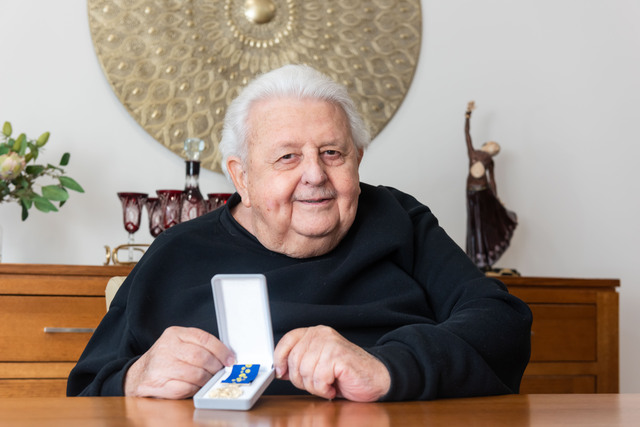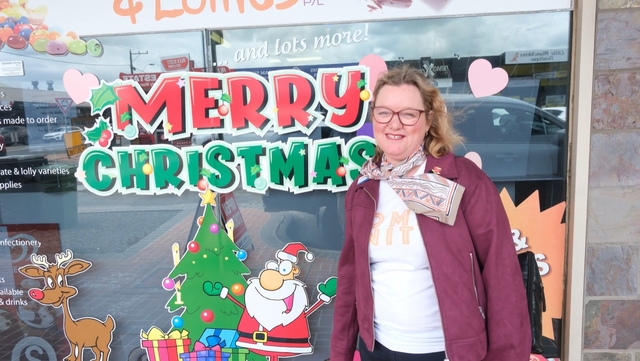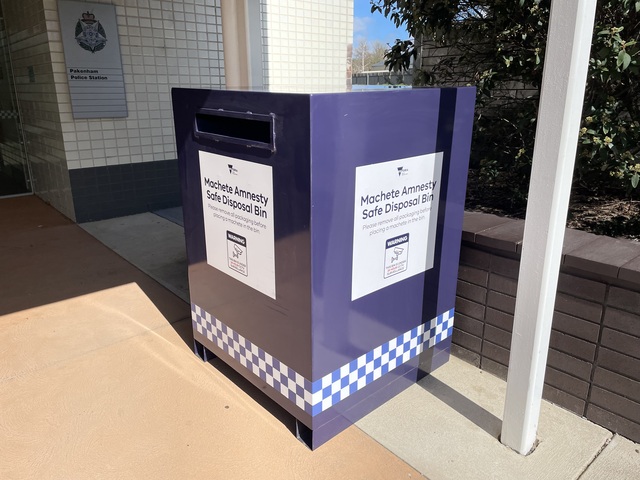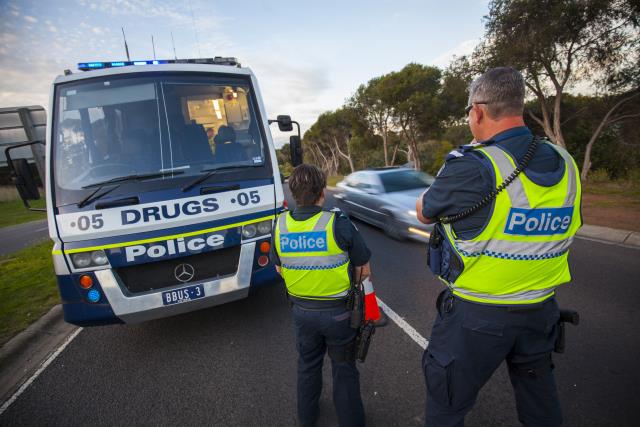PRECEDE
This King’s Birthday isn’t just an honour but vindication for Pakenham’s Colin Tidball, who spent his life not only serving but, at times, challenging it on behalf of veterans and their families. His early life was marked as a survivor of the worst peacetime disaster in Australian military history. What followed is a life dedicated to veterans, firefighters and volunteers. Gazette journalist Corey Everitt reports.
BREAKOUT QUOTE
“I could see the bow of the ship sticking out of the water like a sort of barrel or something, not realising that it was part of the ship.”
Colin Tidbal, 81, received a Medal of the Order of Australia this King’s Birthday in recognition of his achievements as a serviceman, ex-serviceman, legatee, volunteer firefighter and mayor.
“I was surprised, elated, embarrassed, but it is nice to be recognised in that situation because you don’t really go out to do these things expecting to get a medal,” he said.
Born in Brighton, he received the medal from the Commonwealth he served straight out of high school at 17 years old.
Joining the Navy, he served three years as a radar operator in the early 60s, where his job was to detect lurking submarines.
He served in many locations, from aircraft carriers, destroyers to bases on land. The most fateful would be the HMAS Voyager.
This Daring-class destroyer never engaged an enemy and never fired a shot in anger; today it lies under 1.1 kilometres of water, approximately 20 nautical miles off the coast of Jervis Bay, New South Wales.
Under the cover of darkness on 10 February 1964, the then one-of-a-kind ship collided with aircraft carrier HMAS Melbourne during routine exercises.
Voyager was split into two, taking 82 souls with it. Colin was one of the 232 to survive what is still to this day the largest loss of life during peacetime for the Australian Military.
It was a moment that would drastically change his life, where he became a civilian once again shortly after and would be driven by securing better lives for ex-servicemen and widowed families.
“When I look at it, it’s not my medal, it’s recognition of the people that I’ve worked with in all of those endeavours, and my own family, because you’ve got to give up a lot of time to pursue these things.”
Colin was one of approximately 11 men on the deck that night, covering watch duty. He was on the quarterdeck at the stern of the ship.
“The two ships were only a thousand meters apart, going like the clappers, as fast as we could and so I’m standing watching.
“I thought, this is an illusion. That the ships were starting to come together, and then I thought, they are coming together.”
The exercises at the time involved night flying, where Voyager was the plane guard escort.
Voyager maintained the desired 20 degrees off Melbourne’s port quarter for most of the trials. Melbourne would adjust its direction to the wind and Voyager would follow suit.
A series of manoeuvres at 8.40pm would see Voyager on Melbourne’s starboard, where the junior ship was ordered to return to its station.
The Voyager appeared to begin to turn right, where it would loop around behind Melbourne. But a fateful decision by Captain Duncan Stevens saw the destroyer turn left without warning, to where it would cross the path of its superior.
Both would collide at full astern speed in last-ditch attempts to avoid each other. Melbourne would strike Voyager’s port just off the aft side of the bridge. This was in full view of Colin until the destroyer started to roll.
“About that point, I went skidding down the deck from one side to the other into the guardrails.
“I’m hanging through the guardrails with the water underneath me as the ship’s coming up and I don’t know whether it’s going to fall on top of me or I’m going to lose my grip and fall down, with the engines still running and churning underneath me.”
Melbourne was built for the Royal Navy at the end of the Second World War, it was reinforced with a bow that could cut arctic ice before being purchased by the Royal Australian Navy.
“Then we righted and because I’m one of the few people on deck, I thought what the hell’s happened, so I ran forward and then I realised that we didn’t have a front anymore.
“I could see the bow of the ship sticking out of the water like a sort of barrel or something, not realising that it was part of the ship.”
The bow side sank within minutes while the stern remained afloat for about half an hour.
Colin was one of the first to deploy the life rafts and would be one of the last to depart; he was part of the last sweep below for any men still remaining, in darkness, where the half-vessel made its final lurches before going under.
He would be on the final raft, which was half deflated. He recalls a fellow sailor saying, “I will only stop kicking if a shark has bitten my legs off.”
They would remain in the water for hours before Melbourne picked them up; the survivors emerged on deck covered head to toe in oil.
Medals were granted posthumously for the many acts of heroism that night, such as Chief Petty Officer Jonathan Rogers, who was awarded a George Cross for organising evacuations after he realised the escape hatch was too small for him to fit through and led prayer among the remaining crew members as they died.
Electrical Mechanic William Condon chose to stay behind to help the efforts of Rogers and was credited with saving three lives – he received a posthumous Albert Medal from the Crown.
However, the disaster was unfortunately not without its “comedy of errors.”
“We were floating around and somebody said, why don’t we have life jackets?
“I said, because the Navy decided that we got new life jackets and we would be irresponsible with them, so they were locked away.
“Not one person had a life jacket.”
As Colin explains, both vessels recently had a refit where all the escape hatches had a special spanner to open, yet that night, the spanners weren’t there.
Furthermore, the latches were hammered shut, Colin said, out of worries of a leak in the seal. Stuck crews had to use broom handles in their attempts to get them open.
After the tragedy, the survivors were given two weeks off. They would all be dispersed to different stations and many went immediately back to sea.
The need for compensation and relief for ex-servicemen and their families that would drive Colin revealed itself fully in the aftermath.
He recalls the families of those lost on the Voyager being told to leave the Navy settlements within a strict 30 days.
“What they did was the minimum they could compensate; they didn’t allow us to be dealt with by Veteran Affairs. They pushed us into the Commonwealth Government Insurance Scheme.”
The investigation of the tragedy was not promising at the time either. Menzies decided on a Royal Commission. For many sailors, this Navy matter being handled by civilians didn’t sit right and for some in the public, it appeared to politicise the incident.
The Voyager collision is the only event in Australian history to have two Royal Commissions. After widespread criticism of the 1964 commission, the second was initiated in 1967 and reached conclusions against the former.
The most important being the determination that Captain Stevens was medically unfit for command.
Colin returned to civilian life six months after the collision. He did not let the tragedy mire him, rather, it inspired his reintegration into civil society, where he had the power to help his fellow servicemen.
Many survivors banded together outside the Navy to pursue claims and further compensation. Colin has served as president of the HMAS Voyager Survivors Association and was Foundation Secretary between 1972 to 1992.
In 1978, he joined his local fire brigade in Rowville. Only a few years later, he was asked by fellow firefighters if he would be interested in running for council to pursue matters on behalf of the CFA.
In 1982, he was elected to Knox City Council and would serve for 12 years with a term as mayor in 1993.
He has served many years for the RSL and Legacy. He occupied himself with the full experience of veteran matters on one hand and helping families on the other.
“I was covering both, which I thought was sensible because you can’t cover one without the other.”
Starting with the Dandenong branch, he transferred to the Berwick RSL sub-branch in 2007, where he was a long-time vice-president.
His quiet work as a legatee is a point of pride. Colin, among many others, ensured relief and security for families of those who gave their lives in service.
“It was very important that the kids, especially, got a good education, everything was paid for and it wasn’t put back on the mothers.
“You’d pay their school fees, pay their books, pay their holidays, as much as we could.”
Though he is one of few to hold the Australian Navy Medal for service on HMAS Voyager, he has defined his life with further medals to his name, including a National Medal for service to the CFA and a public service medal for his years in local government.
This honour from the King now encapsulates all the dedication he has given to ex-servicemen, their families and the community.







